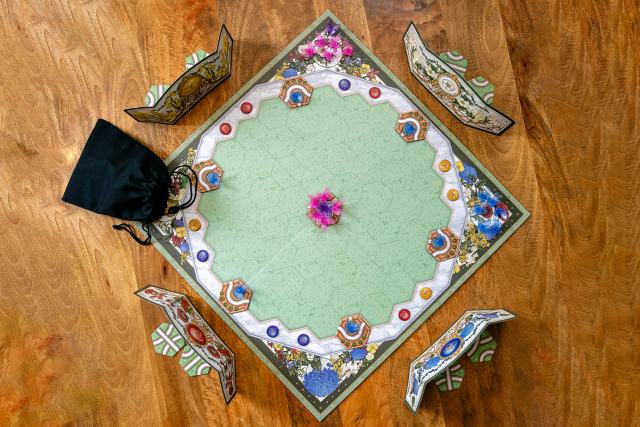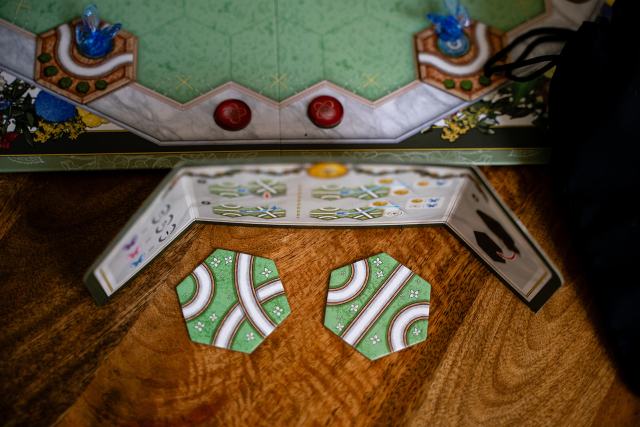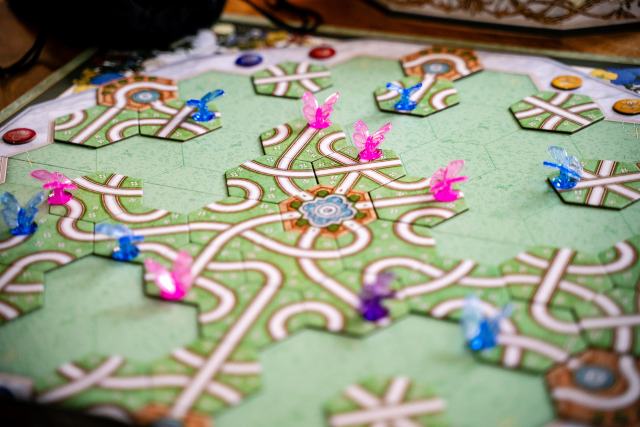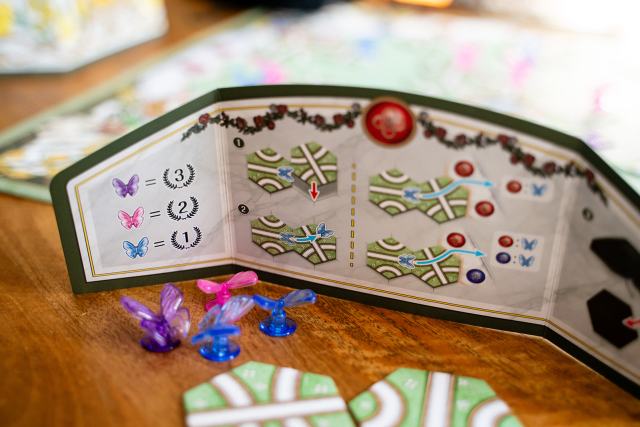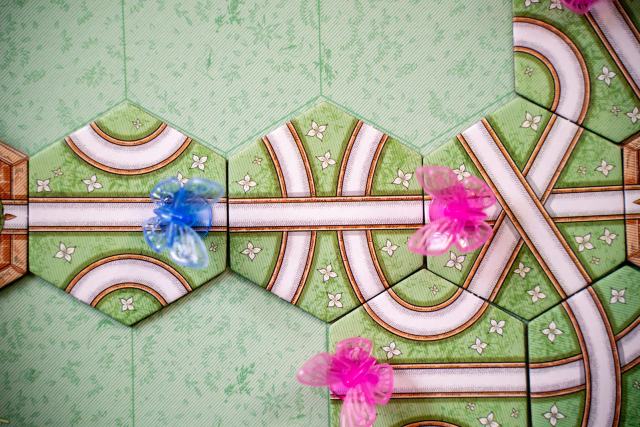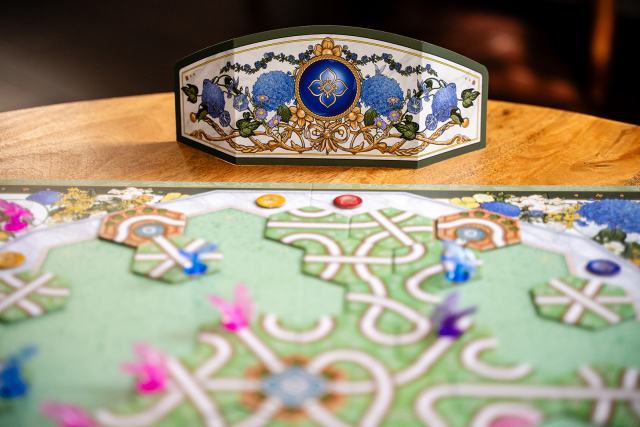Butterfly Garden
- Designer: Reiner Knizia
- Publiahse: Korea Board Games / Capstone Games
- Players: 2-4
- Age: 8+
- Time: 30 minutes
- Played with review copy provided by Korea Board Games
Butterfly Garden is a tile-laying game along the lines of Metro, Tsuro, and Linie 1 in which players build paths bit by bit, with no player owning the individual paths and everyone trying to exploit the paths already present. Unlike those earlier games, however, your goal is to move butterflies from their starting locations on the board to your designated flowerbeds, with the player who scores the most points winning the game.
To set up the game board, place the central fountain tile, then place five pink butterfly figures and one purple butterfly figure to it. Place six fountain tiles on their designated locations on the outer edge of the game board, then place a blue butterfly figure on each fountain tile. Each player places player tokens on flowerbeds between these butterfly tiles on the edge of the game board. Depending on the player count, each player places their player tokens on the designated flowerbeds. There is a chart in the rules to make it clear on which edges the different player tokens are placed. Players start with a hand of 2 Path tiles (drawn from the bag). They are kept hidden behind the player’s screens.
On a turn, a player places a path tile from their hand on any space on the game board, with the only restriction being that a player cannot create a single tile path that connects to edges of the board. Each path tile has three route segments on it, connecting one pair of edges. If a player places a path tile next to a butterfly, that butterfly flies as far as possible along the path so that all players can see where to place path tiles to next move that butterfly (thus, players avoid the mental gymnastics required in Metro and Linie 1 in which nothing moves until a route is complete). When connecting to the central fountain tile, the pink butterflies move off first, with the purple butterfly moving only with the sixth connection. If a player places a path tile so that one butterfly would fly into another, both butterflies fly away and are removed from the game!
When a butterfly is moved to a flowerbed owned by only one player, that player keeps the butterfly. If two players own the flowerbed, then both players collect a butterfly of that color, taking the extra matching colored butterfly from the reserve. Once all the butterflies have been claimed, the game ends. Players earn 3 points for a purple butterfly, 2 for a pink butterfly, and 1 for a blue butterfly. The player with the most points wins.
My thoughts on the game
I have always had a soft spot for Indigo – the game which this is a re-theme of, and trading that one away was one of those trades that I always wanted to take back. I was delighted to see that the game gets another chance here – by a company that has been making a bit of a splash at rejuvenating older games. A few years back, one of my prize games from Spiel was the Korea Board Games version of Princes of Florence.
The art design of the box and tiles are great, and the butterflies that I have look pretty swell. In this game, you both compete and cooperate with the other players to move the butterflies. Sure, you’d love to collect the butterflies to the edge of the board that you control yourself, but you’ll still score full points if that butterfly ends up on a shared side. Make careful note of the possible paths for the butterflies as they move from their starting areas. There is some really cool interplay as you try to work a butterfly to one of your walls – ideally one you have on your own, but you can sometimes get another player to work with you to get a butterfly home and each score some points. There is definitely a lot of motivation to get a butterfly off the board because even if it is only one space away, it can quickly be diverted with a single tile and end up somewhere else completely – or it can be destroyed in a collision of multiple butterflies.
There is a bit of a shift in how the game plays at different player counts; and I think I prefer the four player game the best. In that arrangement, all of the outside walls are shared, and I think the constantly shifting alliances in that player count are the most compelling. (I prefer that push/pull of shifting alliances to the 3 player push/pull of trying to share a butterfly versus getting it all to yourself).
As far as I can tell, there is only one rule change from the original – players now get two tiles in their hand instead of simply drawing a tile and playing it. I like this small subtle change as it does give the player a bit more of a chance to make a strategy on tile placement. As you draw your new tile at the end of your turn, you also have a good chance to look at the board and start working on the possible placements for your tiles; so this added dimension doesn’t add much to the game length.
I personally love the way that these route building games grow and form intricate designs on the table, and I find the finished board something beautiful to see. My brain likes the routes in Indigo as everything is straightforward. You don’t have to mentally calculate / trace lines as much here as the butterflies move to the end of their line with each tile placement. It’s easier for me to see where they are going as a result. One thing to always remember is to have all players watch out for an illegal play – the board has clear outlines on which plays are verboten – but we still had a couple of occasions where we missed it and had to go back a bit to fix the issue.
Overall, Butterfly Garden is an easy going, easy to teach/learn game that is quite suitable for a gateway game. You can teach someone the rules in about 30 seconds, and the movement rules and scoring are found on the back of the screens – so everyone has all the information they need at all times. It is definitely on the light side, and the complexity is definitely at the lighter end. There is no variation from game to game other than the tile draw, but it is definitely a soothing game for me, and one that I enjoy both playing and watching it develop on the table. For the game group, this is an easy 15 to 20 minute super filler. This new version will probably end up being a keeper. I’ve had seller’s remorse since letting Indigo go all those years ago, and now I have a second chance at the game.
Read this review of an older version of the game, Indigo by Brandon Kempf:
https://opinionatedgamers.com/2020/03/07/surviving-the-purge-indigo-game-review-by-brandon-kempf/
Ratings from the Opinionated Gamers
- I love it!
- I like it. Dale Y, John P
- Neutral.
- Not for me…


